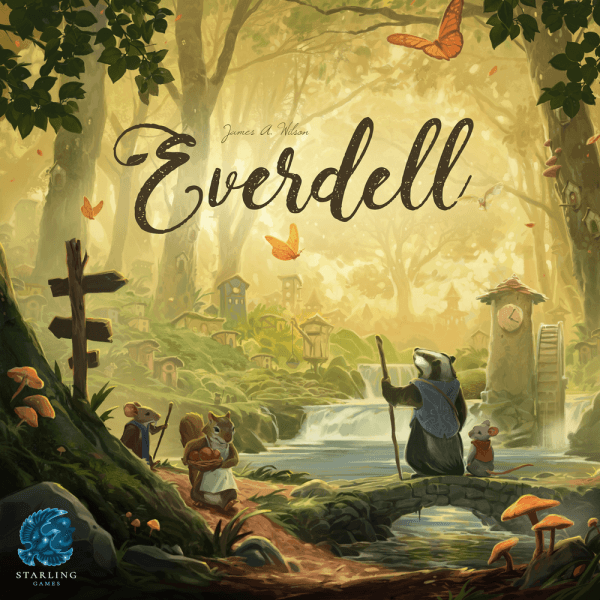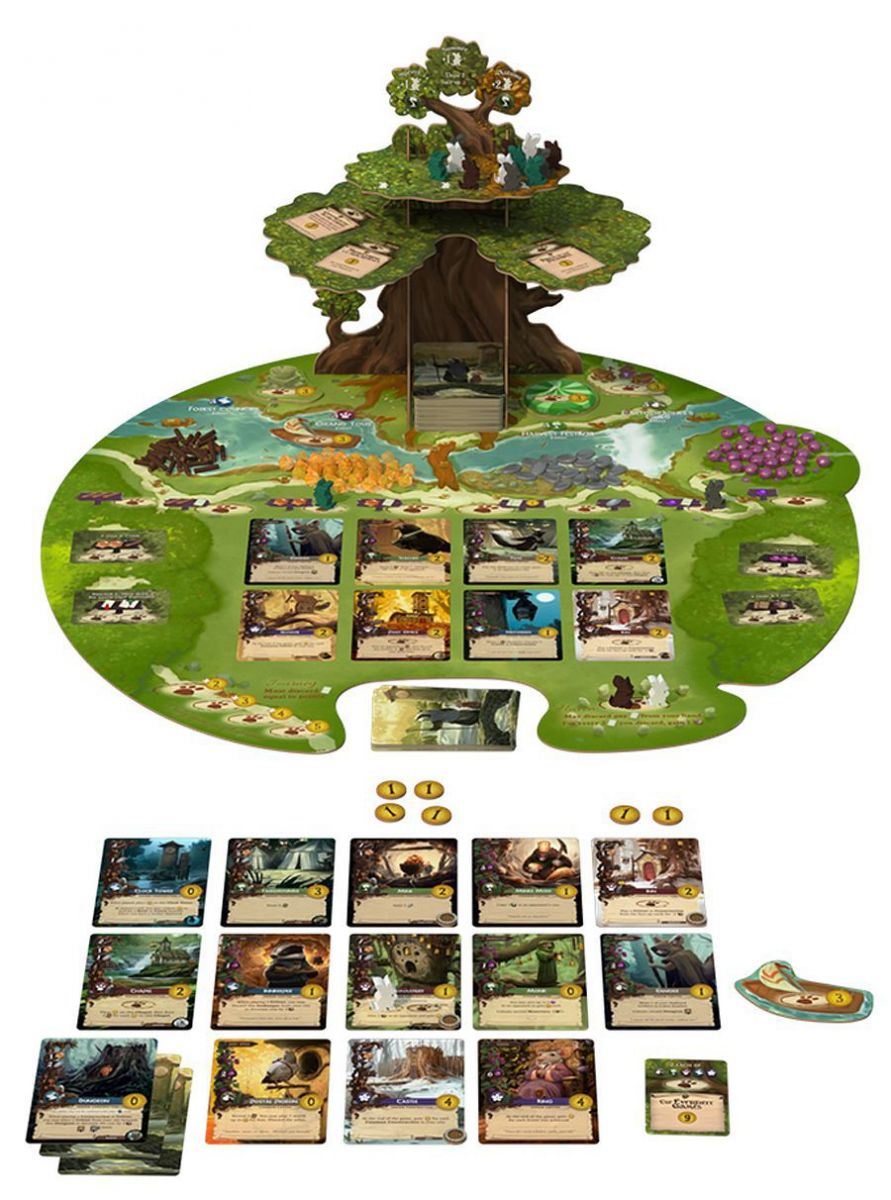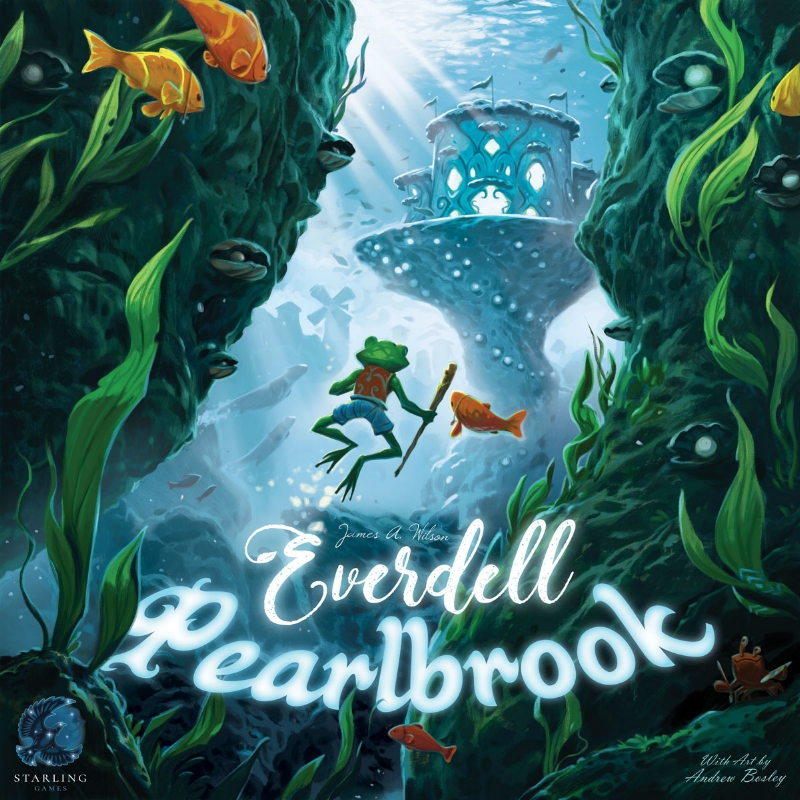Construct a City and Meet Ambassadors of Underwater Citizens in Everdell and the Pearlbrook Expansion

Lead woodland creatures to glory in Everdell, a worker placement and tableau-building game.
Gameplay
Everdell is a 1-4 player game in which players take on the role of anthropomorphic animals trying to establish communities across the countryside. Players will choose an animal type and start with a set number of cards in hand (determined by the number of players) from which to build one’s tableau: a city with no more than 15 cards. To do this, players must set their wooden animal meeples on a number of worker placement spaces within the beautifully constructed central board, depicting the flora and fauna of Everdell. Central to this setup is the Evertree, a 3D deciduous which plays host to player meeples not yet available, event cards which provide point bonuses, and the monstrous pile of cards which will be pertinent to building one’s city. The bulk of the board has spaces for gaining resources (wood, berries, resin, and pebbles) to meet the requirements to build cards that will be placed in a player’s own tableau, as well as chances to draw more cards. There are also bonus spaces called wonders upon which, once the requirements have been met, players may place their workers for points at the end of the game. There is also the meadow, which is a display of 8 face-up cards that anyone can take and build so long as they meet the resource requirements.
The game lasts four rounds, or seasons. Players begin play in Spring and take one of two actions on their turn: placing a worker to gain resources and/or cards or building a card and placing it in their tableau. Once players have exhausted their options in a round, they may perform the Prepare for Season action, which allows them to collect their workers from the board (or cards), gain additional workers (one additional worker in Summer and Autumn and two in the Winter). Once all players have reached the end of winter, points are scored by the amounts indicated on the cards in their city tableaus as well as any bonuses or victory point tokens they have accumulated. The player with the most points wins.
The game’s first expansion, Pearlbrook, adds even more challenges and opportunities. More animals have been added to the pool for player selection, new cards providing new tableau opportunities, a frog ambassador allowing players to visit the underwater city of Pearlbrook, new event and worker placement cards, new wonders, and a new resource: pearls.
Pearlbrook does not change the gameplay radically, but rather invites players to gain pearls for additional point scoring opportunities. Pearlbrook adds a new section to the main board with four new worker placement spaces. When players meet the requirements of one of these spaces (by the type of cards within their cities), they may visit the space and carry out the action alloted by the card. These spaces may only be visited by the frog ambassador meeple each player has gained, so they can only occur once per round. If a player is the first to turn over one of the cards in Pearlbrook, they also receive a pearl. Pearls may be used at the end of the game to score points to help fulfill the new bonus opportunities on the board that replace the base game’s scoring areas.

Review
Everdell will immediately delight families by the artwork. Artist Andrew Bosley’s eye-catching cover playfully captures the alternative world players will inhabit as woodland creatures building up new communities. Play is simple enough, with worker placement iconography and functions being easy to understand.
Where Everdell shines is in how rounds are resolved. In most games, players receive an equal amount of turns in a round before the next round begins. That is rarely the case with Everdell. Depending on the cards in one’s hand, as well as those in the shared meadow area, players may find themselves extending their rounds as they place workers, gather resources, and play cards into their tableau. It’s not uncommon to have players doing actions in the Fall while others are still doing actions during the Summer round.
This also adds a layer of forethought and complexity to placing workers. Depending on the player count, certain worker spaces may only allow for one or two players. This can make certain resources harder to get if you’re out of sync with the action. There are cards both on the board and in one’s city that can help mitigate these pain points, but being able to build them may take some time -- and that’s even if they show up at all in a game.
The deck of cards in the base game alone contains over 100 cards. Though many are duplicates of the same critters or constructions available, there is no guarantee they come up in any given game. However, the shared meadow alleviates some of these concerns as well and some action spaces may be available that allow players to trade in cards in their hand or in the meadow for a refresh. This non-stop action of Everdell keeps the game moving and the options fresh from game to game.
However, the cards can be the bane of the core gameplay. Though the options are plentiful, there are times when a player’s engine may never reach its full potential because of the luck of the draw. Likewise, as beautiful as it is, the 3D Evertree that towers above the game board is finicky and often a roadblock to drawing cards and seeing what events are available. It’s also true that, more often than not, players' meeples are going to fall off the tree during the seasons in 3 and 4 player games.
The most satisfying aspect of Everdell is how actions can chain together. By building particular constructs, you may be able to also build the associated critter at no charge. For example, if a player has the resources to build the Inn and also have the Shopkeeper in their hands, they can build the Inn and then also play the Shopkeeper for free into their cities. Of course, maybe it’s not a sound strategy to do this if your city tableau is getting close to 15 cards and you’re managing what you want in your city for maximum points and/or action opportunities, but there are also mechanisms at work that may encourage players to build often due to actions that benefit burying or discarding cards for further resources, points, or actions.

Pearlbrook adds an extra layer of strategy without changing much of the core gameplay. The unique cards that make up Pearlbrook’s underwater haven allow players to trade in cards for points, pearls, and other resources. The additional critters and constructions it adds to the game’s decks also ease some of the more strenuous options of the base game. The new Pearlbrook cards on the new board do provide some new opportunities to power up one’s gains, but they are not as game changing or revolutionary as they should be to differentiate the expansion from just a beautiful add-on to the board. However, Pearlbrook feels essential overall because it adds more to the overall action of the game even if it does not provide too much depth.
Designer James A. Wilson has created a fine balancing act. While Pearlbrook does not add as much depth to the game as it may crave, keeping Everdell at a borderline light-medium family game is its best course of action. There’s enough depth, strategy, and engine building to keep hardcore gamers involved but enough ease of play and actions that young gamers learning more complex mechanics and ideas can not only stay competitive but potentially win. The game’s solo mode can also be challenging, even if it only functions as a dummy second player that denies cards, actions, and resources. But the desire to fashion a different engine out of what’s available is the continuing appeal of the game.
Pros: Beautiful game, satisfying tableau and engine building mechanics, unique round structure, great components
Cons: Unwieldy Evertree on the central board, large amount of cards may cause analysis paralysis




